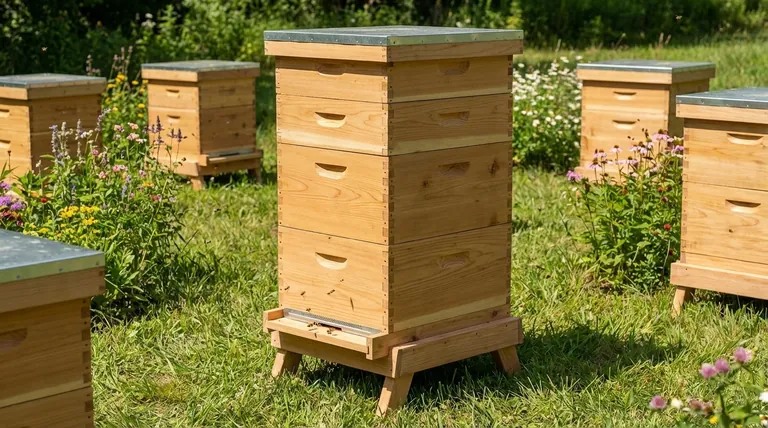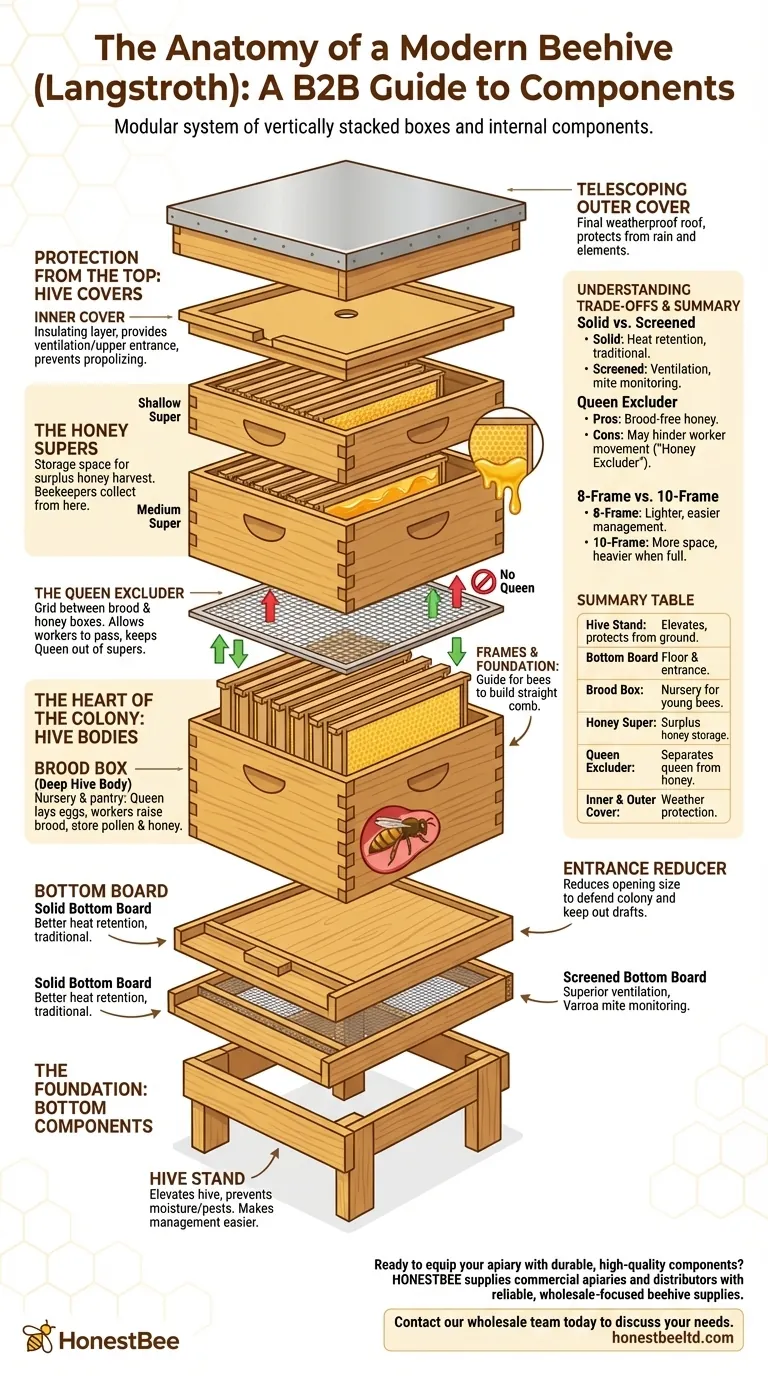At its core, a modern beehive is a modular system of vertically stacked boxes and internal components. The most common design, the Langstroth hive, consists of a bottom board, one or more hive bodies (brood boxes and honey supers) containing frames, an inner cover, and an outer cover. Optional but common components include a hive stand, entrance reducer, and queen excluder.
A beehive is not just a box; it's a carefully engineered environment. Each component serves a specific function designed to support the colony's natural behaviors while allowing the beekeeper to manage the hive and harvest honey efficiently.

The Anatomy of a Modern Beehive
The vast majority of beekeepers today use the Langstroth hive, a design that has been the standard for over 150 years. Its genius lies in its modularity and its respect for "bee space," allowing components to be added, removed, and inspected without destroying the colony's comb.
The components are stacked vertically, and we will examine them from the ground up.
The Foundation: Bottom Components
These parts form the base of the hive, providing a stable platform, an entrance for the bees, and protection from the elements.
The Hive Stand
A hive stand elevates the entire structure off the ground. While not strictly essential, it is highly recommended.
Lifting the hive prevents moisture from seeping in from the ground, deters pests like skunks, and makes it easier for the beekeeper to work without bending over excessively.
The Bottom Board
The bottom board is the floor of the beehive. It provides the landing area and entrance for the bees to come and go.
These come in two main types: solid and screened. A solid board is traditional, while a screened board provides better ventilation and is a key tool for monitoring and managing Varroa mite populations.
The Entrance Reducer
This is simply a small, notched block of wood placed at the hive entrance. Its purpose is to shrink the size of the opening.
Reducing the entrance helps a small or new colony defend itself from robber bees or wasps. It is also used during colder months to keep out drafts and mice.
The Heart of the Colony: The Hive Bodies
These are the large rectangular boxes where the bees live, raise their young, and store their food.
The Brood Box
Also called the "deep hive body," the brood box is the largest box and forms the lower chamber of the hive. This is the colony's nursery and pantry.
Here, the queen lays her eggs, and the workers raise the young (the brood). The bees also store pollen and honey in this chamber for their own consumption. A colony may have one or two brood boxes.
The Honey Super
Supers are the boxes placed on top of the brood box. They are typically shallower than the brood box.
Their sole purpose is to provide space for the bees to store excess honey. This is the honey that the beekeeper will eventually harvest.
Frames and Foundation
Both brood boxes and honey supers are filled with removable frames. Each frame holds a single sheet of comb.
Beekeepers typically install a sheet of foundation—made of wax or plastic and imprinted with a honeycomb pattern—into each frame. This gives the bees a guide, encouraging them to build straight, even comb that is easy to inspect and harvest.
Managing the Colony: The Queen Excluder
A queen excluder is a flat grid of wire or plastic that is placed between the brood box and the honey supers.
The gaps in the grid are large enough for worker bees to pass through but too small for the larger queen. This ensures she stays in the brood box to lay eggs, keeping the honey in the supers free of brood and ready for a clean harvest.
Protection from the Top: The Hive Covers
The final components form the roof of the hive, protecting the colony from weather and intruders.
The Inner Cover
The inner cover is a flat board that sits directly on top of the uppermost super. It provides an insulating layer of dead air space.
It also has a small, notched opening that can be used for ventilation or as an upper entrance for the bees. Importantly, it prevents the bees from gluing the outer cover to the hive body with propolis.
The Telescoping Outer Cover
This is the final roof of the beehive. It's called "telescoping" because its sides hang down over the top hive body, protecting the seams from rain.
Often covered with a sheet of metal for durability, the outer cover is the hive's primary defense against the elements.
Understanding the Trade-offs
Choosing your hive components involves a few key decisions, each with its own set of advantages and disadvantages.
Solid vs. Screened Bottom Boards
A solid bottom board is traditional and offers better heat retention in cold climates. However, a screened bottom board provides superior ventilation, which is crucial for reducing moisture in humid climates, and is an invaluable tool for monitoring Varroa mite levels without opening the hive.
The Queen Excluder Debate
Using a queen excluder guarantees brood-free honey supers, simplifying the extraction process. However, some beekeepers believe it can hinder worker bee movement, slightly reducing the efficiency of honey production. This is often referred to as a "honey excluder" by its detractors.
8-Frame vs. 10-Frame Equipment
Langstroth hives are commonly sold in 10-frame or 8-frame widths. A 10-frame box offers more space for brood and honey but is significantly heavier to lift when full. An 8-frame system is lighter and easier for many beekeepers to manage, but you may need more boxes to provide the same total volume.
Assembling Your First Hive
Your choice of components should align with your beekeeping goals and physical capabilities.
- If you are a beginner starting your first colony: Begin with the essential kit: a stand, a bottom board, one or two brood boxes with frames, an inner cover, and an outer cover.
- If your primary goal is maximizing honey harvest: Plan to add multiple honey supers and use a queen excluder to ensure your honey is clean and easy to extract.
- If you are concerned about hive health and ease of management: Consider using a screened bottom board for mite monitoring and 8-frame equipment to keep the boxes a manageable weight.
Understanding how each component functions empowers you to create the ideal home for your bees and a successful system for yourself.
Summary Table:
| Component | Primary Function |
|---|---|
| Hive Stand | Elevates hive, prevents moisture/pests |
| Bottom Board | Floor and main entrance for bees |
| Brood Box | Nursery for raising young bees |
| Honey Super | Storage for surplus honey harvest |
| Queen Excluder | Keeps queen out of honey supers |
| Inner & Outer Cover | Protects colony from weather |
Ready to equip your apiary with durable, high-quality beehive components?
HONESTBEE supplies commercial apiaries and beekeeping equipment distributors with the reliable, wholesale-focused supplies needed to build and manage productive hives at scale. From durable hive bodies and frames to essential tools, we provide the equipment that supports healthy colonies and maximizes honey yields.
Contact our wholesale team today to discuss your specific needs and request a quote.
Visual Guide

Related Products
- HONESTBEE Side Bar Slicer High Speed Precision Cutting for Bee Frame Making Machine
- Professional Stainless Steel J-Hook Hive Tool
- Professional Engraved Round Hive Number Tags for Beekeeping
- Beehive Entrance Discs Plastic Bee Entrance Disc for Bee Hives
- Electric Flatting and Embossing Machine with Tray for Beekeeping
People Also Ask
- What is the purpose of a small desktop bee frame forming machine? Automate Frame Assembly for Beekeepers
- What equipment do you need to make honey? A Complete Guide to Starting Your Apiary
- What role do frames play in a beehive? The Key to Modern, Manageable Beekeeping
- How often should beehive frames be inspected and cleaned? A Guide to Hive Health & Honey Quality
- What qualities are important for someone starting in beekeeping? Build a Thriving Apiary with the Right Mindset



















